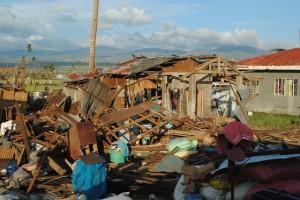
The devastation in the Philippines is shocking.
Like Katrina, Typhoon Haiyan (known as Yolanda to Filipinos) was a storm of epic proportions. Like Katrina, the storm made landfall at the peak of its power. And like Katrina, much of its damage will be caused by inadequate preparation and human action.
Human action has been a popular topic this week — Haiyan struck as UN delegates were making their way to Poland for the 19th round of climate change discussions.
The Philippine delegate to the conference, a member of the Philippines Climate Change Commission, has said he will fast throughout the 12-day meeting or “until a meaningful outcome is in sight.”
Previous discussions at the UN have not been markedly successful.
So the timing of the typhoon could be, ironically and sadly, pretty good — but it would be a hard way to win progress on international climate change agreements. Early, unreliable estimates projected that some 10,000 people had been killed in the typhoon. The current death toll stands at almost 2,000.
Haiyan was the strongest storm ever recorded to have hit land (not to be confused with the strongest storm ever recorded). And yes, climate change is real and does contribute to more extreme weather events. Yes, we need the UN to agree to stop letting ourselves spend half a trillion a year subsidizing the fossil fuel industry, among other low-lying fruits of carbon change.
But the reason aid can’t get to many of the affected areas is not climate change.
For decades, the Philippines has been plagued by corruption. This relatively prosperous nation has not been able to maintain its roadways. The area hardest hit by Haiyan already had a spotty power supply and limited accessibility.
As populations increase, pushing into more and more insecure areas, it won’t matter if we stop climate change in its tracks or even reverse it. Storms will continue to come. We need to encourage not just the halt of pollution, but investment infrastructure, from roads to housing to microgrids that can keep people safe.
As relief efforts continue in Tacloban, the devastation worsens. Walls have collapsed on people looking for food. Drinking water is scarce — and the threat of disease is real. (We have seen cholera outbreaks in disaster areas before.)
I hope that this disaster spurs some action — in Poland, the Philippines, and the rest of the world. (You can donate directly to the Red Cross here), and I hope the action comes with the realization that we don’t have one problem to solve here.




